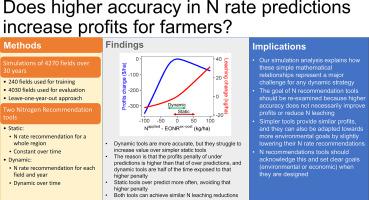Agricultural Systems ( IF 6.1 ) Pub Date : 2021-10-01 , DOI: 10.1016/j.agsy.2021.103275 German Mandrini 1 , Cameron M. Pittelkow 2 , Sotirios V. Archontoulis 3 , Taro Mieno 4 , Nicolas F. Martin 1

|
CONTEXT
Improving nitrogen (N) fertilizer recommendations for maize (Zea mays L.) in the US Midwest has been the focus of much research, yet there is no agreement for which methodology is the best to balance trade-offs between production and environmental outcomes. This study investigated the strengths and limitations of two broad approaches: dynamic and static recommendation tools. Dynamic tools use advanced technology to predict the Economically Optimum N Rate (EONR) using year-specific soil, weather, and crop growth characteristics to detect conditions that need lower or higher N rates. Static tools provide regional N recommendations that are static over time, maximizing long-term profits rather than predicting the best EONR for each field and season.
OBJECTIVE
The objective of this work was to explain the interactions between the accuracy, profitability, and environmental losses for different N recommendation tools under a wide range of production scenarios.
METHODS
For this, we used a calibrated synthetic dataset of 4200 fields over 30 years. In the first part, we compared multiple N recommendations tools belonging to the static and dynamic groups. In the second part, we selected each group's best tools and compared them in detail.
RESULTS AND CONCLUSION
From an economic view, results indicate that increasing profitability by increasing the accuracy in EONR predictions with dynamic tools is challenging. The reason is that these more accurate tools are not perfect, and around half of the time, they under predict. In that situation, the yield penalty is higher, and the economic loss is usually not compensated by savings in N fertilizer costs associated with other more accurate recommendations. The static recommendations avoid this penalty by recommending slightly higher N rates, providing similar profits. From an environmental view, both tools can reduce N leaching by 15%, dynamic tool by being more accurate overall, but the static tool could achieve it by recommending on the lower end of their current recommended N profitable range.
SIGNIFICANCE
Our analysis suggests that we need to re-think the goals of N management tools. Higher complexity in N management may not necessarily increase profits and reduce N leaching. In fact, there is current potential to reduce N leaching by simply reducing static recommendations without hurting profits. For either approach, this study highlights the need to develop other ways (education, environmental awareness, policies) to account for environmental benefits and provide clear incentives for farmers to adopt these tools and increase the eco-efficiency of agriculture.
中文翻译:

使用模拟建模了解静态和动态氮肥工具之间的差异
语境
改善美国中西部玉米 ( Zea mays L. ) 的氮肥建议一直是许多研究的重点,但对于哪种方法最能平衡生产和环境结果之间的权衡,尚无一致意见。本研究调查了两种广泛方法的优缺点:动态和静态推荐工具。动态工具使用先进的技术来预测经济最佳氮肥率 (EONR),使用特定年份的土壤、天气和作物生长特征来检测需要更低或更高氮肥率的条件。静态工具提供随着时间的推移是静态的区域 N 建议,最大限度地提高长期利润,而不是预测每个领域和季节的最佳 EONR。
客观的
这项工作的目的是解释在各种生产场景下不同 N 推荐工具的准确性、盈利能力和环境损失之间的相互作用。
方法
为此,我们使用了 30 年来 4200 个字段的校准合成数据集。在第一部分,我们比较了属于静态和动态组的多个 N 个推荐工具。在第二部分,我们选择了每个小组的最佳工具并进行详细比较。
结果与结论
从经济角度来看,结果表明,通过使用动态工具提高 EONR 预测的准确性来提高盈利能力具有挑战性。原因是这些更准确的工具并不完美,而且大约有一半的时间,它们预测不足。在这种情况下,产量损失更高,经济损失通常无法通过与其他更准确的建议相关的氮肥成本节省来弥补。静态推荐通过推荐略高的 N 率来避免这种惩罚,提供类似的利润。从环境的角度来看,这两种工具都可以将 N 浸出减少 15%,动态工具可以通过更准确的整体来实现,但静态工具可以通过推荐其当前推荐的 N 盈利范围的低端来实现这一目标。
意义
我们的分析表明,我们需要重新思考 N 个管理工具的目标。N 管理的更高复杂性不一定会增加利润并减少 N 浸出。事实上,目前有可能通过简单地减少静态推荐而不损害利润来减少 N 浸出。对于这两种方法,本研究强调需要开发其他方式(教育、环境意识、政策)来考虑环境效益,并为农民采用这些工具和提高农业生态效率提供明确的激励措施。











































 京公网安备 11010802027423号
京公网安备 11010802027423号